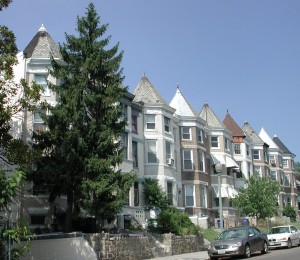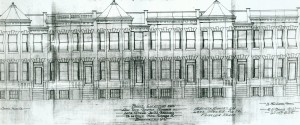 Bloomingdale is one of the most homogenous neighborhoods in Washington in terms of housing type, size, and design, yet it was built by approximately a dozen developers. Homogeneity resulted from several factors. The neighborhood was constructed in little more than a decade; it was intended for a single socio-economic class; and, until 1908, when Wardman introduced the front-porch row house in Bloomingdale, the architecture was based on the late-nineteenth-century vernacular Washington row house found in all quadrants of the city. While the two houses in the left photo appear to be similar, they were, in fact, built by different developers. 75 Seaton Street (right) was built by Wardman in 1904 with Nicholas R. Grimm as architect. 77 Seaton Street was built by Thomas Haislip in 1902, and he is listed as architect. There are fifteen houses at the western end of Seaton Street that were built by three different developers, yet they form a cohesive block.
Bloomingdale is one of the most homogenous neighborhoods in Washington in terms of housing type, size, and design, yet it was built by approximately a dozen developers. Homogeneity resulted from several factors. The neighborhood was constructed in little more than a decade; it was intended for a single socio-economic class; and, until 1908, when Wardman introduced the front-porch row house in Bloomingdale, the architecture was based on the late-nineteenth-century vernacular Washington row house found in all quadrants of the city. While the two houses in the left photo appear to be similar, they were, in fact, built by different developers. 75 Seaton Street (right) was built by Wardman in 1904 with Nicholas R. Grimm as architect. 77 Seaton Street was built by Thomas Haislip in 1902, and he is listed as architect. There are fifteen houses at the western end of Seaton Street that were built by three different developers, yet they form a cohesive block.
Wardman employed two architects to design the houses that he built in Bloomingdale. The first, Nicholas R. Grimm, an experienced row-house architect, was responsible, in 1903 and 1904, for the design of seventy houses, a third of which were row-house flats. In 1905, Wardman replaced Grimm with Albert H. Beers, also an experienced designer who was to become one of Washington’s most prolific architects. Although the architect changed, the houses remained similar, with differences largely in the details. For example, Beers substituted Grimm’s flat window lintels of rough-cut stone with voussoir lintels of smooth concrete, a change that gave the design a more classicizing look. Beers continued Wardman’s practice of using only one design for a row of houses that was intended for middle-income residents, providing variety only by alternating round wooden finials with metal spires. Wardman was willing, however, to vary one row from another by constructing some with square bays, others with polygonal ones. Having found a successful formula, Wardman remained with it, benefiting from a commonly held belief that identical houses were morally superior, represented equality, and created community cohesion.
1904, for the design of seventy houses, a third of which were row-house flats. In 1905, Wardman replaced Grimm with Albert H. Beers, also an experienced designer who was to become one of Washington’s most prolific architects. Although the architect changed, the houses remained similar, with differences largely in the details. For example, Beers substituted Grimm’s flat window lintels of rough-cut stone with voussoir lintels of smooth concrete, a change that gave the design a more classicizing look. Beers continued Wardman’s practice of using only one design for a row of houses that was intended for middle-income residents, providing variety only by alternating round wooden finials with metal spires. Wardman was willing, however, to vary one row from another by constructing some with square bays, others with polygonal ones. Having found a successful formula, Wardman remained with it, benefiting from a commonly held belief that identical houses were morally superior, represented equality, and created community cohesion.
